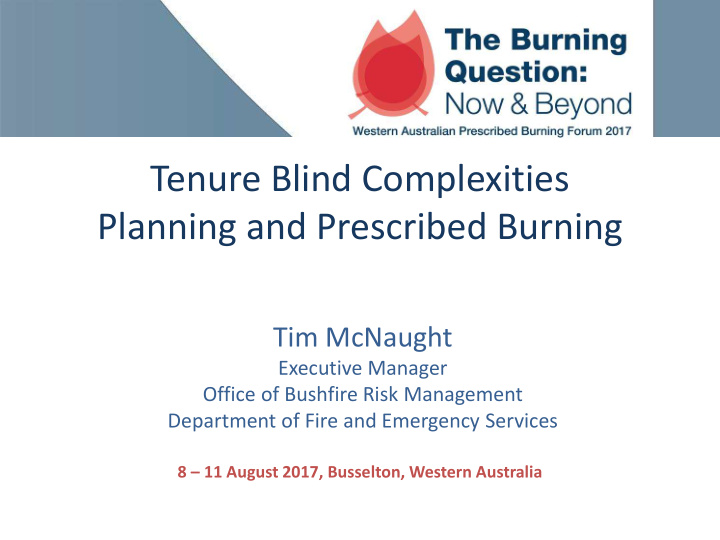



Tenure Blind Complexities Planning and Prescribed Burning Tim McNaught Executive Manager Office of Bushfire Risk Management Department of Fire and Emergency Services 8 – 11 August 2017, Busselton, Western Australia
What’s this workshop about? To understand issues that participants perceive to be inhibiting tenure blind planning for burning activities.
How are we going to get there? • Three presentations (35 mins) • Workshop – Table group work (25 mins) • Scenario 1 • Scenario 2 – Table individual solutions (10 mins) – Table feedback to workshop (16 mins) – Individual priorities (4 mins)
Current Western Australian Legislative Tools Michelle Smith A/Manager Legal and Legislation Department of Fire and Emergency Services 8 – 11 August 2017, Busselton, Western Australia
Firebreak Notices Picture: courtesy of the Shire of Kalamunda
Bush Fire Risk Treatment Standards Picture credit: Map of Bushfire Prone Areas (DFES)
Bush Fire Risk Treatment Standards Picture credit: DFES
Tenure blind mitigation What might utopia look like? Katie MacWilliams Policy and Projects Officer Department of Biodiversity, Conservation and Attractions Parks and Wildlife Service 8 – 11 August 2017, Busselton, Western Australia
All entities that undertake prescribed burning are able to participate in a manner which doesn’t unreasonably restrict their capacity to perform their statutory (or other) functions
Overview • Legislative framework • Shared standards • Planning is risk appropriate • Resourcing
Legislative Framework
Shared standards
Photo: O Donovan / DBCA
Photo: R Boykett / DBCA Photo: O Donovan / DBCA Photo: O Donovan / DBCA
Photo: PICA / DBCA
Photo: PICA / DBCA
Photo: P Blechynden / DFES
Photo: P Blechynden / DFES
Planning is risk appropriate
Photos: DBCA Photo: M Pasotti / DBCA Photo: DBCA
Photos: O Donovan / DBCA
Photos: O Donovan / DBCA
Resourcing
Photo: DBCA Photo: M Pasotti / DBCA Photo: DBCA
Photo: L Sage / DBCA Photo: PICA / DBCA
Photo: O Donovan / DBCA
“All entities that undertake prescribed burning are able to participate in a manner which doesn’t unreasonably restrict their capacity to perform their statutory (or other) functions”
NSW Framework for Risk Management and Prescribed Burning Dr Simon Heemstra Manager Community Planning NSW Rural Fire Service 8 – 11 August 2017, Busselton, Western Australia
Coordination Framework Rural Fires Act 1997 STATE Fire Agencies Bush Fire Coordinating Committee Forestry Local Government Farmers Association Crown Lands Primary Industries LOCAL Environmental Police & Emergency Bush Fire Management Agencies & Groups Services Committee
Planning Framework Bush Fire Risk Management Plans Prepared by the local BFMC Tenure Blind risk assessment 5 year treatment plan including SFAZ and APZ maintenance. Risk managed by a suite of treatments including Community Education Property Planning Preparedness
Implementation Framework BFMC prepares Annual Works Program. Bush Fire Mitigation & Resilience Funding Program Bush Fire Environmental Assessment Code Multi Agency burn plans & operations
Private Property & Development Control Planning for Bush Fire Protection 10/50 Vegetation Clearing Code of Practice Hazard Complaints Process
Future Directions for BFRMP Current Model – Asset centric Treatments Asset • Inherits risk (priority from Threat x Vulnerability = asset) Consequence x • Described only Likelihood = Risk Zones • Mapped or described • Not linked to assets or treatments
Future Directions for BFRMP Future Model – Treatment centric Assets Landscape Treatments • Has a value & vulnerability • Mapped • Exposure from landscape • Priority from risk modelling reduction to all assets • Risk assigned to each asset Vulnerability Treatments Alter the vulnerability of Zones the asset, people or Spatially linked to environment landscape treatments
Phoenix Modelled results House loss vulnerability Wind Profiles 40% Number of times an individual house is impacted by different ignitions 1 2 - 5 6 - 10 11 - 15 16 - 26 21 - 30 31 - 50 51+
Phoenix Modelled House loss from results ignition source Wind Profiles 40% Number of houses impacted from source of ignition 0 Property 1 - 30 30 - 50 50 - 100 100 - 200 200 - 500 500 – 1,000 1,000 – 2,000 2,000 – 5,000 5,000 +
Asset Impact Maximum Fuels BFMC No. Assets Impacted Asset Impact 0.0 0.1 0.2 0.3 0.4 - 0.6 0.7 - 1.4
Asset Impact Current Fuels BFMC Asset Impact No. Assets Impacted 0.0 0.1 0.2 0.3 0.4 - 0.6 0.7 - 1.4 HR Completed
The Workshop
Workshop Session Scenario 1. (17 minutes) Having no knowledge of the tenure what are the issues you may be confronted with in planning for this proposed burn in Western Australia? As a table group list the issues and rank the four most significant issues inhibiting a tenure blind approach.
Workshop Session Scenario 2. (8 minutes) • Tenure management arrangements have now been determined. – Purple area is DFES – Green area is P&W Service – Blue Area is private property – Brown Area to E is Main Roads WA Knowing the tenure arrangements, reconsider the list of issues. What is the new priority of your issues (one to four)?
Format of the Butchers Paper Issue 1 – (one to two Issue 2 – (one to two sentences to describe it) sentences to describe it)
Workshop Session Brainstorm - Individual Solutions. (10 minutes) • Individually consider the top four issues identified at your table and using the post-it notes write down a solution or solutions for each of the issues.
Workshop Session Table Summary to Workshop Group (2 minutes per table) • Summarise the four issues and briefly discuss if there was any change in prioritisation.
Workshop Session Thankyou! Individual priorities • Place a coloured dot beside the four issues you think are the greatest issues facing a tenure blind planning approach in WA.
Recommend
More recommend